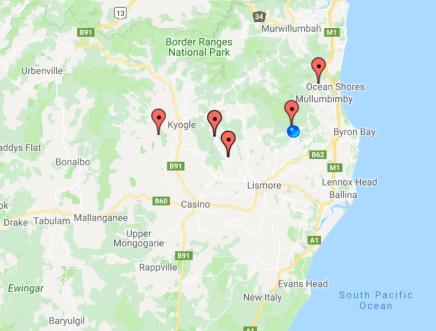
This map shows known occurrences within the Northern Rivers area.
We have not yet mapped location data from carers in other regions as only the wildlife group/branch is currently known.
This page provides other data/evidence related to the illness and attempts to identify patterns from this data and present this in the form of a Q&A.
NOTE THAT THIS DATA IS FROM BEFORE 2019 - SINCE THEN THERE HAVE BEEN MANY MORE CASES IN THIS AREA AND MANY REPORTED CASES FROM OTHER AREAS
AS OF 2019 WIRES Northern Rivers Branch had SEVEN active soft release sites. Of these sites FIVE have had joeys presenting with the illness (see map below).

This map shows known occurrences within the Northern Rivers area.
We have not yet mapped location data from carers in other regions as only the wildlife group/branch is currently known.
One release site has been in operation for around 20 years. Although it is only in the past 4-5 years that the pattern of this illness has been identified, it is thought that joeys were exhibiting it (but in fewer numbers, and with less severely) more than 10 years ago. A highly consistent case is documented from 2010 (see case study data).
Another soft release site has been operating since 2013. Incidents of the illness at this site have been high and it is this site that has led us to identify, describe and collect data on the illness. Statistics from this site (Since June 2013 to April 2019) are presented below:
*Note that this only includes joeys that were in care with us long enough to be named. It doesn't count those in transit, or those who died or were euthanised immediately.

Out of 147 joeys, 50 (34%) are believed to have had the illness (to April 2019).
22 of these 50 joeys died - for 13 joeys (9%) "the illness" was highly likely to be the cause of death; for 5 joeys (3%) it was the probable cause of death; for 4 joeys (3%) it was a possible cause of death
28 joeys (19%) were thought to have the illness but survived
Use of Doxycycline started in late 2017 (taking Nellie as the first joey treated). Before then the survival rate was 47%. Since starting use of Doxycycline the survival rate is 61%. [Note that incident rates have increased since that point from 31% of all joeys to 42% of all joeys. This may be because of an increase in prevalence OR because we are more conscious of early signs, assume it is the illness and treat earlier].
THIS DATA WILL BE UPDATED SOON AS PART OF THE NEW RESEARCH STUDY.
In 2017 an attempt was made to contact macropod carers in OTHER wildlife groups across NSW to see if they had experienced symptoms in their joeys similar to those documented by us. A relatively small number of responses were forthcoming, however a good proportion of the cases reported sounded very similar to this syndrome. It is unclear to what extent the request for information reached all carers and we suspect there may be far more cases that were not reported. A summary table (Word format) was produced at the time attempting to collate the information provided and the similarity between symptoms described and our cases in Northern NSW. We suspect this is the “tip of the iceberg” since we only reached a small number of actual carers in that initial communication.
Since then some wildlife carers have since been in communication with us, particularly after viewing this website. We are fairly certain that similar cases are occurring in the following areas: